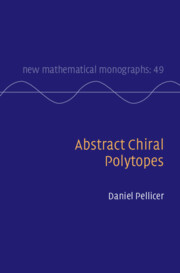Book contents
- Frontmatter
- Contents
- Preface
- 1 Introduction
- 2 Abstract Regular and Chiral Polytopes
- 3 Groups Related to Chiral Polytopes
- 4 Polytopes Constructed from Other Polytopes
- 5 Families of Chiral Polytopes
- 6 Skeletal Polytopes
- Appendix A A Few Treats on Euclidean Geometry
- Appendix B A Few Words about Numbers
- Appendix C Open Problems
- References
- Index
3 - Groups Related to Chiral Polytopes
Published online by Cambridge University Press: 23 March 2025
- Frontmatter
- Contents
- Preface
- 1 Introduction
- 2 Abstract Regular and Chiral Polytopes
- 3 Groups Related to Chiral Polytopes
- 4 Polytopes Constructed from Other Polytopes
- 5 Families of Chiral Polytopes
- 6 Skeletal Polytopes
- Appendix A A Few Treats on Euclidean Geometry
- Appendix B A Few Words about Numbers
- Appendix C Open Problems
- References
- Index
Summary
The automorphism group is one of the most natural groups that acts on polytopes, since it captures its level of symmetry. The connection group is another group that acts naturally on the flags of a polytope; it can be interpreted as a recipe to recover the structure of the polytope from its flags. The chirality index is a measure of how far a chiral polytope is from being regular, and it is linked to a group called the chirality group. This chapter addresses these three groups and their interactions.
Keywords
- Type
- Chapter
- Information
- Abstract Chiral Polytopes , pp. 101 - 207Publisher: Cambridge University PressPrint publication year: 2025

